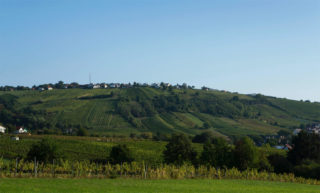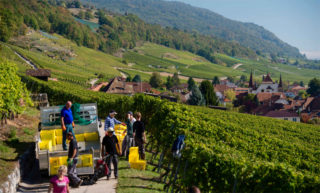From Rustic to Refined
Although the village of Pommard lies at the heart of the Côte d’Or, its reputation is said to be lagging behind the other villages for some time. Pommard’s heavy soils are partly responsible for its traditionally rustic, dark and powerful Pinot Noirs that need long ageing. But they don’t match the current preference for more elegant, ready-to-drink wines. But vintners are catching up with the trend.
Until the inception of the AOC-system in the 1930s the wines from Pommard were highly sought after. Some say this was because of its name, which is relatively easy to pronounce for foreigners. More likely is that Pommard produced wines that met the current demand. Its capacity to age and its feasibility for transportation rather than its origin, were the reasons for its reputation. So, when the terroir-based AOC-system was established, Pommard needed to reinvent itself and, as the famous winemaker and wine writer Rajat Parr implies, it is still in the process of doing so. Paul Zinetti, the winemaker at Comte Armand, confirms this. “Pommard’s biggest challenge is to show to winelovers that the appellation can produce refined and delicate Pinot Noirs.”
Combes
The Côte d’Or is a fifty-kilometer long ribbon of vineyards running from Fixin, close to Dijon, in the north to Santenay in the south. Pommard, just southwest of the region’s wine hub of Beaune, lies in the southern part of the Côte d’Or, also known as the Côte de Beaune. The Côte d’Or stretches out along an escarpment that falls down towards the east, exposing the slopes to the beneficial morning sun, which is considered better for grape growing than the afternoon heat.
The escarpment is indented by so-called combes, small funnel-shaped valleys through which cool air from the plateau streams down into the vineyards. Especially in times of climate change and rising temperatures the vineyards close to the combes benefit from the cooling effect.
Inside the combes vineyards have a different exposure to the sun. On the northside of the combe you will find vineyards facing south and southeast, and on the southside ones that have a northeastern and northern exposure. To create complexity vintners can thus blend wines from parcels with different characteristics.
Wine from the combe
The south-facing Premier Cru Clos des Arvelets is located in Pommard’s combe. David Rebourgeon of Domaine Rebourgeon-Mure makes one of his favourite single vineyard wines from it. “The Clos des Arvelets is an enclosed family monopole that belonged to my great-grandmother who divided it up between her children”, he recounts.
The bountiful 2017 vintage, generally considered quite accessible, had wide-meshed tannins with a little edge, seemingly fitting in with the stereotypical Pommard. However, the wine had a friendly character, probably due to the southern orientation of the vineyard, the good climatic conditions of the vintage and its steep terraces, but also because of gentle extraction, reduced use of new oak and destemming.
The road
Pommard’s terroirs are divided up in three zones, within which there are individual vineyards with different qualities. The northern part, close to Beaune, has chalky clay and gravel soils, whereas the soils in the southern part, towards Volnay, consist of the typical red, iron-containing clay. The best vineyards are found in these two areas. As David Rebourgeon says: “Near Beaune the wines are more elegant, towards Volnay they are more structured.”
On the flatter east side the humbler vineyards are located.
At the Côte de Nuits, north of Beaune, the Grand Cru vineyards are located halfway up the escarpment and are flanked on both sides, above and below, by the Premiers Crus. The village wines are typically made of grapes from the flatter vineyards east of the famous provincial D974 road. But south of Beaune the road turns somewhat to the southwest and starts cutting across the Premier Cru vineyards rather than forming a demarcation between the higher grounds with shallower, better-drained and poorer soils and the lower areas with deeper, more fertile soils. As a result you’ll find some of Pommard’s Premiers Crus on the east side of the road. Pommard doesn’t yet have any Grands Grus.
Wine from across the road
Clos Micaults is one of those Premier Cru vineyards east of the D974. Domaine Joseph Voillot makes a single vineyard wine from it. Etienne Chaix, a descendent of Joseph Voillot, who joined the winery in 2016, says: “This part of the Pommard terroirs does not provide the complexity and length that you could expect of a Pommard Premier Cru, but it does deliver marked finesse and elegance.” And indeed, during our tasting the Clos Micault 2018 stood out through its slim body, notes of hibiscus tea and the subtle use of (new) oak.
So, both the Arvelets and the Micaults seemed to defy Pommard’s prevailing image. The way they make wine at Voillot illustrates why.
Less oak, less sulphite, more terroir
Since Joseph Voillot handed over the winery to his son-in-law Jean-Pierre Charlot in the 1980s, winemaking has shifted slowly towards sustainable practices in the vineyard and to complete destemming, more focus on fruit, reduced use of new oak (from 30 per cent to 10 to 20 percent) and smaller sulphite additions. Thus Domaine Voillot pursues a refined and elegant style of Pinot Noir, making as little interventions as possible. Chaix, who is now slowly taking over the reins, carries forward Charlot’s methods.
Just in Pommard, Chaix produces four Premier Crus, all following the same recipe. The grapes are hand-harvested with initial sorting of the grapes in the vineyard. If needed, further selection takes places in the cellar. The must is spontaneously fermentated with wild yeasts. Chaix says: “The differences between our wines come essentially from the terroir. We are working hard to achieve that.”
Current vintages
The largest part of what I tasted was from the accessible 2017 and 2018 vintages. With enough aeration or decanting, the wines are drinkable, but would improve if cellared under the right conditions for a couple of years. In 2017 the flowering and fruit set took place under good conditions. During the growing season there was in general little thinning and the yields were relatively high.
The 2018 vintage had a hot summer resulting in ripe fruit. “We started the harvested on 31 August”, David Rebourgeon says. The wines seemed deeper in colour, were rounder, and had more dark berry fruit, lower acidity and silkier tannins than their 2017 counterparts. Also in cooler vineyards grapes reached full ripeness. Therefore the differences between Premiers Crus and village wines can be small, as Jancis Robinson remarked in one of her articles. Nonetheless, I tasted marked difference between Voillot’s village wines and their Premiers Crus.
Pommard (photo: Domaine du Comte Armand)
The vineyards
Arguably the most famed vineyard of Pommard is the Clos des Epeneaux owned by Domaine du Comte Armand. With its 5,23 hectare it is one of the largest monopoles of the Côte d’Or. From its multitude of soils the current winemaker, Paul Zinetti, vinifies five individual wines that are later blended into his highly sought-after Premier Cru Clos des Epeneaux. “It is easy to make a monster with high tannins from the Clos des Epeneaux,” Zanetti says. “That is why you need to vinify gently”.
His wines are precise, fresh and elegant, have a characteristic chalky, stony minerality, an unrivalled intensity and complexity and a long lasting finish. If the 2017 opens up more easily, the 2016 is more elegant; Zinetti calls it a “charmeur”. While both have a spicy note and the minerality in common, the palette of flavours of the 2016 is richer, with hints of black tea, yarrow and rosewood. Despite the fact that the maturation of the Clos des Epeneaux takes place in 30 percent new wood, its impact is subtle, and appears only gradually. Some faint dried fruit rounded off the flavour profile. In short, also Comte Armand’s wines don’t match Pommard’s rustic image.
Grand Crus?
The Clos des Epeneaux is squeezed in between the Grands Epenots and the Petits Epenots vineyards, the latter supposedly being the better of the two. Together called Les Epenots, they are for Pommard’s northside what Les Rugiens is for its southside. Just like Les Epenots, Les Rugiens is divided into two, Les Rugiens Bas and Les Rugiens Hauts. There is talk of elevating Les Rugiens to Grand Cru status, but this may only apply to the supposedly better lower part (Bas). Also for Les Epenots lobbying for recognition as a Grand Cru is going on.
Primarily driven by their soils, the characters of both are different. Les Rugiens, the name deriving from the word rouge, or red, has iron-rich soils, whereas the iron inclusions in Les Epenots are much smaller. While Les Petits Epenots has a chalky marl soil, Les Grands Epenots’ soil is more gravelly. Voillot makes single vineyard wines from both Les Petits Epenots and Les Rugiens Bas, providing a great opportunity to compare both top terroirs. The Les Epenots 2018 showed sweet spice and more fruit, including figs, raisins and prunes, with a waft of smoke and leather rising out of the glass. The Les Rugiens has brighter, but less obvious fruit, some stony, chalky minerality and subtler spice. Overall, the Les Rugiens has more complexity, is better balanced and a tad more elegant.
Unique Selling Point
Pommard may still produce some of the darker and more rustic Burgundy Pinot Noirs, but there are numerous growers who create leaner, terroir driven wines. As David Rebourgeon says: “Perhaps we should be a little more fashionable and shed some preconceived ideas about Pommard wines.” In the case of Rebourgeon (and Voillot and Comte Armand), that seems more a matter of communication than of wine production. Zinetti agrees: “We are on the right track.”
If Pommard’s terroirs give rise to heavier wines, then I’d prefer to see that as its unique selling point. But people like Étienne Chaix, Paul Zinetti and David Rebourgeon show that reduced use of new oak, sustainable farming, gentle vinification and moderate extraction can form the basis of very elegant and unique wines, perhaps a shade darker than the average Burgundy Pinot Noir, but no less delicious.
A version of this article (in Norwegian) was published in the October 2020 issue (print) of Apéritif magazine.








Comments